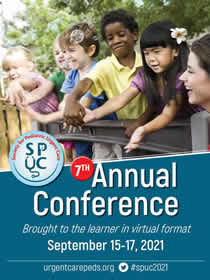Words From the Frontline: Running a large Pediatric Urgent Care and continuing to do so successfully during the pandemic
By Traci Downs-Bouchard MD
Marc Leder MD is the Director of Nationwide Children’s Hospital Urgent Care Network which includes seven Pediatric Urgent Care sites. Dr. Leder is a Professor of Clinical Pediatrics and pediatric emergency medicine trained; he has been working for Nationwide Children’s Hospital for 28 years.
Dr. Leder: "If I were to summarize the past 14 months for our PUC division, I would say navigating in such an uncertain and ambiguous environment required communication, innovation, and adaptability. Here is a summary of some of our responses to the pandemic and how we made it work, which with I am sure many of our SPUC members had similar experiences.
Enhanced communication was key in our response, especially in the early months of the pandemic when things were changing rapidly. That included communication at the leadership level, between departments, then within our department, including all of the providers, and all the way through to our nursing staff - a top-down approach to help ensure we were all on the same page and everyone felt confident and safe about continuing to work (as an aside, we never shut our doors or even reduced our hours at any of our sites). It was tempting in the beginning to send out several emails a day to multiple groups; what eventually worked best was our daily ‘ED COVID Update’ spreadsheet in the same place each day, which had all the necessary information about scheduling, COVID testing guidelines, PPE, etc., and helped keep everyone on the same page and minimize questions or confusion. We are still using this, but thankfully as the pandemic evolves, this moved to weekly and now, monthly. Those of us in the Emergency Department and on the Urgent Care Leadership Team had a daily COVID phone call to keep us in alignment with the rest of the hospital’s COVID plans and objectives.
Innovation - from the first few days of the pandemic we needed to adapt to a rapidly changing environment. We had to assure that all staff had enough and proper PPE, were appropriately N-95 fitted with use of CAPR Hood for some, and how to properly don and doff varying types of PPE. Time was spent creating, and sometimes re-creating, our COVID testing centers and testing protocols. We initiated a drive-through center very early in the pandemic, with centralized phone screening and a referral hotline, so that we could test as many people as needed. In-person visits were reserved for those who truly needed to be seen. I am proud of all our staff who adapted so quickly; our testing site went through many changes, from location - as seasons and climate changed - to hours of operations as the volume of people needing testing increased. We used our parking garage, tents, fans, and outdoor heaters to help keep our fearless group of nurses accommodated while they served this very important function in our community. We are thankful that our PPE supply was always adequate, thanks to a recycling program from a local industry (Batelle), and due to our staff being properly trained on which PPE to use and how to use it. We used nurse educators as ‘super users’ and video modules about our learning center, as well as laminated placards at all our sites showing the proper way to don and doff PPE. Our daily ‘ED COVID Update’ spreadsheet also offered helpful PPE reminders before it all became second nature for us.
Other creative changes were needed in scheduling. As volumes decreased and staffing needed adjustments, we created a ‘COVID floatpool’, allowing us to cover for colleagues who were in quarantine. In addition, many of our nurse practitioners were used in other areas of the hospital (e.g. Employee Health to help screen employees with possible exposures and requiring testing). We had about 500 total quarantine days for our staff, including family exposures. Adjusting the staffing and scheduling daily to accommodate for this took some finagling, but I am proud to say we had no gaps in our scheduling.
Telehealth was also adapted to accommodate more patients. While telehealth as a future plan had been discussed in our division prior to the pandemic, we did not previously offer telehealth services. As the pandemic continued, we saw this as a need for our patients. I am proud of our staff who worked with me to quickly and successfully get our telehealth system up and running. This included outfitting six of our seven sites with the technology and hardware to offer these visits, training our staff, creating specific telehealth notes for our EHR, and creating a rather elaborate schedule for offering telehealth to our patients daily, without creating extra shifts for our providers or nurses. We have received excellent feedback from patients, who love this option, and we plan to continue this service even as the pandemic dissipates.
I think we have all learned a lot during this past year; most importantly that we are resilient, that teamwork, good communication skills, and being flexible and creative in times of crisis makes the difference, and - even during trying times - we can still give excellent and compassionate care and be satisfied and proud of the place where we work."
JOIN OR RENEW WITH SPUC TODAY!

SPUC's 7th Annual Conference
Brought to the learner in virtual format
Early Registration Rates
through September 7
Mobile Meeting Guide
Program, Faculty, Exhibits and more!
_____________
Committee Opportunities
Want to make a difference in our developing specialty of Urgent Care Pediatrics?
Join a SPUC Committee or workgroup!
 Summer 2021
Summer 2021 to Home Page
to Home Page
